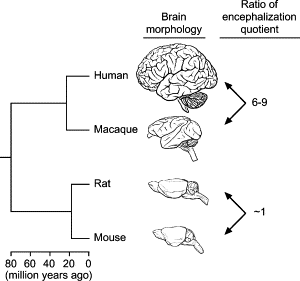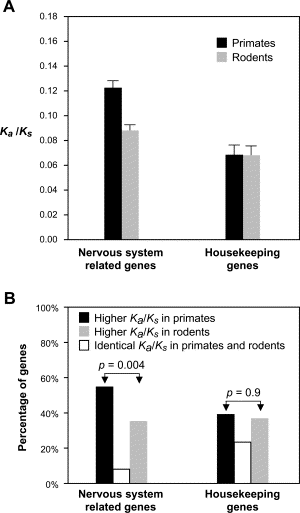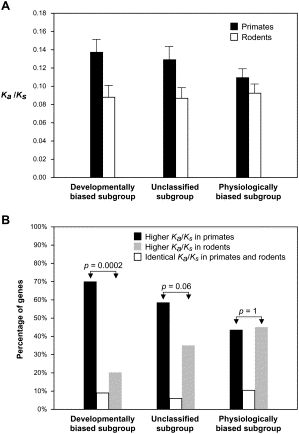December 29, 2004
Fast times in the primate brain: no special providence
 An article published in Cell today compared the apparent rate of genetic evolution in four cases: nervous-system genes vs. "housekeeping" genes in primates vs. rodents (here, if you've got a subscription). The abstract:
An article published in Cell today compared the apparent rate of genetic evolution in four cases: nervous-system genes vs. "housekeeping" genes in primates vs. rodents (here, if you've got a subscription). The abstract:
Human evolution is characterized by a dramatic increase in brain size and complexity. To probe its genetic basis, we examined the evolution of genes involved in diverse aspects of nervous system biology. We found that these genes display significantly higher rates of protein evolution in primates than in rodents. Importantly, this trend is most pronounced for the subset of genes implicated in nervous system development. Moreover, within primates, the acceleration of protein evolution is most prominent in the lineage leading from ancestral primates to humans. Thus, the remarkable phenotypic evolution of the human nervous system has a salient molecular correlate, i.e., accelerated evolution of the underlying genes, particularly those linked to nervous system development. In addition to uncovering broad evolutionary trends, our study also identified many candidate genes—most of which are implicated in regulating brain size and behavior—that might have played important roles in the evolution of the human brain.
Steve Dorus, Eric J. Vallender, Patrick D. Evans, Jeffrey R. Anderson, Sandra L. Gilbert, Michael Mahowald, Gerald J. Wyckoff, Christine M. Malcom, and Bruce T. Lahn. "Accelerated Evolution of Nervous System Genes in the Origin of Homo sapiens". Cell, Vol 119, 1027-1040, 29 December 2004
The lede of the 12/29/2004 Guardian report by Alok Jha has a more breathless, not to say awestruck, take on these results:
The sophistication of the human brain is not simply the result of steady evolution, according to new research. Instead, humans are truly privileged animals with brains that have developed in a type of extraordinarily fast evolution that is unique to the species.
An article by Ronald Kotulak in the Chicago Tribune takes a similar tack, saying that "brain-building genes mutated at a tremendously rapid rate in humans, compared with the brains of chimpanzees, macaque monkeys, rats and mice".
But there's nothing in the Cell article to support the view that humans are "truly privileged" as a result of "extraordinary fast evolution", or that the rate of genetic evolution responsible for the human brain has been "tremendously rapid". The article provides strong evidence that brain size and complexity has been subject to greater selective pressure among primates than among rodents, and that this is especially true of the human lineage among the primates. But the calculated rates of brain evolution at the molecular level are small relative to (say) snake venom or virus coat proteins.
At first I thought that the Guardian's science writer had interpreted the research overenthusiastically, as journalists sometimes do, but both the Guardian and Tribune articles includes quotes suggesting that (some of) the researchers -- at least Bruce Lahn -- are complicit in this (what I take to be) misrepresentation, and perhaps even primarily responsible for it. From the Tribune article:
The findings, Lahn said, disprove the contention of other scientists who say the evolutionary process leading to the bigger human brain was simple adaptation to change--like growing bigger antlers, longer tusks or gaily colored feathers.
"We've proven that there is a big distinction," he said. "To accomplish so much in so little evolutionary time--a few tens of millions of years--requires a selective process that is categorically different from the typical processes of acquiring new biological traits."
And from the Guardian, again quoting Lahn:
Researchers have recognized for a long time that evolution has focused on brain size and complexity in the primate and especially hominid lineages, based on measurements of brain size relative to body size -- the numbers on the right in the picture above (from the Dorus et al. article) are (ratios of) encephalization quotients (here based on the equation EQ = BrainWeight/BodyWeight0.28), indicating that macaques have about 6 times as much brain relative to their body size as rats and mice do, while humans have about 9 times as much. (You'd get somewhat different numbers by using a different exponent in the EQ equation, but under any reasonable interpretation, primates are more encephalized than rodents, apes are more encephalized than other primates, and humans are more encephalized than other apes). What the Cell article adds to this quantitative evidence from gross anatomy is quantitative evidence based on molecular changes in DNA sequences, showing that nervous-system-related genes have evolved faster in primates than in rodents. There's no attempt to show that the rate of primate brain evolution is "extraordinarily fast", just that it's faster than brain evolution among rats and mice."The making of the large human brain is not just the neurological equivalent of making a large antler. Rather, it required a level of selection that's unprecedented."
The researchers looked at 214 genes "demonstrated to play important roles in the nervous system", "expressed exclusively or predominantly in the brain", or "implicated in various diseases of the nervous system, such as brain malformations, mental retardation, and neurodegeneration". They compared these nervous-system-related genes with a set of 95 "housekeeping" genes, which are "involved in the most basic cellular functions such as metabolism and protein synthesis" and "exhibit ubiquitous expression" (i.e. in all tissues and situations). The rate of protein evolution was estimated in terms of the ratio between nonsynonymous ( Ka) and synonymous (Ks) substitution rates in the DNA sequence. ("Synonymous" substitutions don't chance the amino acid that's coded for, while "nonsynonymous" substitions do.) In the primate line, humans and macaques were compared; in the rodent line, mice and rats were compared. As graph A below shows, the Ka/Ks ratio was about 37% higher for the nervous-system genes in primates vs. in rodents, while the ratio for housekeeping genes was about the same for both genera. Graph B shows that about 55% of the nervous-system-related genes had higher Ka/Ks ratios in primates, as opposed to about 36% with higher ratios in rodents, while the balance was nearly even for housekeeping genes.

As the Cell article explains, these results could have two explanations:
One is stronger positive selection on nervous system genes in primates than rodents. The other is weaker functional constraint on these genes in primates. We argue that the possibility of weaker constraint seems unlikely, on the basis that the primate nervous system is far more complex (and therefore likely demanding greater precision in gene function) relative to the rodent nervous system.
In order to add to the plausibility of their favored explanation, the authors further subdivide the nervous-system-related genes into three groups:
The developmentally biased subgroup contained 53 genes that included patterning signals of the developing nervous system, downstream components of such signals, transcription factors that specify neuronal phenotypes, and regulators of neural precursor proliferation, apoptosis, differentiation, migration, and morphogenesis. The physiologically biased subgroup had 95 genes, comprised predominantly of neurotransmitters, their synthesis enzymes and receptors, neurohormones, voltage-gated ion channels, synaptic vesicle components, factors involved in synaptic vesicle release, metabolic enzymes specific to neurons or glia, and structural components of the nervous system. The unclassified subgroup contained the remaining 66 genes.
The "developmentally biased" subgroup shows the greatest effect, suggesting that the key thing is brain size, structure and organization, not nervous-system physiology.

There's more interesting stuff in the article, including evidence from comparisons including chimps and squirrel monkeys that the rate of nervous-system evolution at the molecular level has been greater in the hominin lineage than in the rest of primate evolution, and a (tentative) argument that human brain evolution has involved "a very large number of mutations in many genes" rather than "a small number of key mutations in a few genes".
But there's no support in the Cell article for humans being the "privileged" beneficiaries of "a type of extraordinarily fast evolution that is unique to the species", as Alok Jha tries to tell us in the Guardian. On the contrary, the authors write
Might genes involved in tissues other than the nervous system also display accelerated evolution in primates? We argue that this is a distinct possibility given the precedent found in nervous system genes. In particular, accelerated evolution of genes might be found in tissue systems that are especially relevant to the adaptation of primates, such as the immune system, the digestive system, the reproductive system, the integumentary system, and the skeletal system.
They don't ask whether genes under selective pressure in other species might show equally fast or faster changes -- but that's because they already know that the answer is "yes". In fact, the original perspective on this is that Ka/Ks ratios need to be greater than 1 to demonstrate that adaptive evolution is occurring at all, and you can see from the graphs above that the average ratio for nervous-system-related genes in the Cell paper was about 0.12. For lists of higher ratios, you can consult The Adaptive Evolution Database (TAED) here. TAED "is designed to provide, in raw form, evolutionary episodes in specific chordate and embryophyte (flowering plants, conifers, ferns, mosses and liverworts) protein families that might be candidates for adaptive evolution" and "contains a collection of protein families where at least one branch in the reconstructed molecular record has a KA/KS value greater than unity, or greater than 0.6."
For example, the sample page linked in the TAED database documentation includes the gene for the (snake venom) protein phospholipidase A2 in the Malayan Krait, Bungarus Candidus, with Ka/Ks of 2.27. Browsing for a minute or two, I found a cell adhesion protein in the zebrafish with Ka/Ks of 4.55. And on the lower links of the Great Chain of Being, the Ka/Ks ratio for sequenced genes of SARS virus during the epidemic in 2002-2003 was as high as 1.98.
Some individual genes among the "nervous-system related" set studied in the Cell paper had Ka/Ks as high as 0.833 in the primate comparison (that was MCPH1, "implicated in the control of brain size"), and the average of 0.12 was significantly higher than the rodent average of 0.09 for the same genes, but this is not some unprecedented, biologically unique level of extraordinarily fast evolution.
Given all of this, it's hard to understand why one of the paper's authors, Bruce Lahn, told the Chicago Tribune that "mutations in genes that build the brain exploded in the human line when humans split from monkeys 20 to 25 million years ago" (emphasis added). What's going on here?
There's a clue in another quote from the Tribune article, this one from Art Caplan at Penn's Bioethics Center:"There is this desire for humans to have a privileged position in terms of other animals," he said. "We try to find in intelligence or language or something that seems to distinguish us, because we want to be more like the angels than like the animals.
"But, unfortunately, the animals keep talking and being social and using tools," Caplan said. "Every time we come up with something, they do it too."
The difference is that while some animals may have one or two of these attributes in rudimentary form, humans have all of them in abundance, he said.
"The new findings look like the human brain and its hyper-evolutionary development might give us that special status relative to all the other living things around us," Caplan said.
But there's no "hyper-evolutionary development" here, unless I'm missing something. We're just seeing the molecular correlates of the long-recognized increased encephalization of the human lineage, with rates of change that are not spectacular at all relative to thousands of other well-documented cases elsewhere in nature. The resulting degree of encephalization is unique, and clearly causes (and is probably also caused by) some qualitative differences in language, tools and social organization. But what's special about us is what we see and do every day, not the Ka/Ks ratios of the brain-related genes in our lineage.
[Update 12/30/2004: As expected, this story has spread widely in the press. The Independent writes about "evolutionary overdrive"; SciTech today features "unprecedented natural selection pressure" and an "explosion of genetic mutations in the brain"; and so on through more than 50 other stories so far indexed by Google News. ]
Posted by Mark Liberman at December 29, 2004 11:24 AM